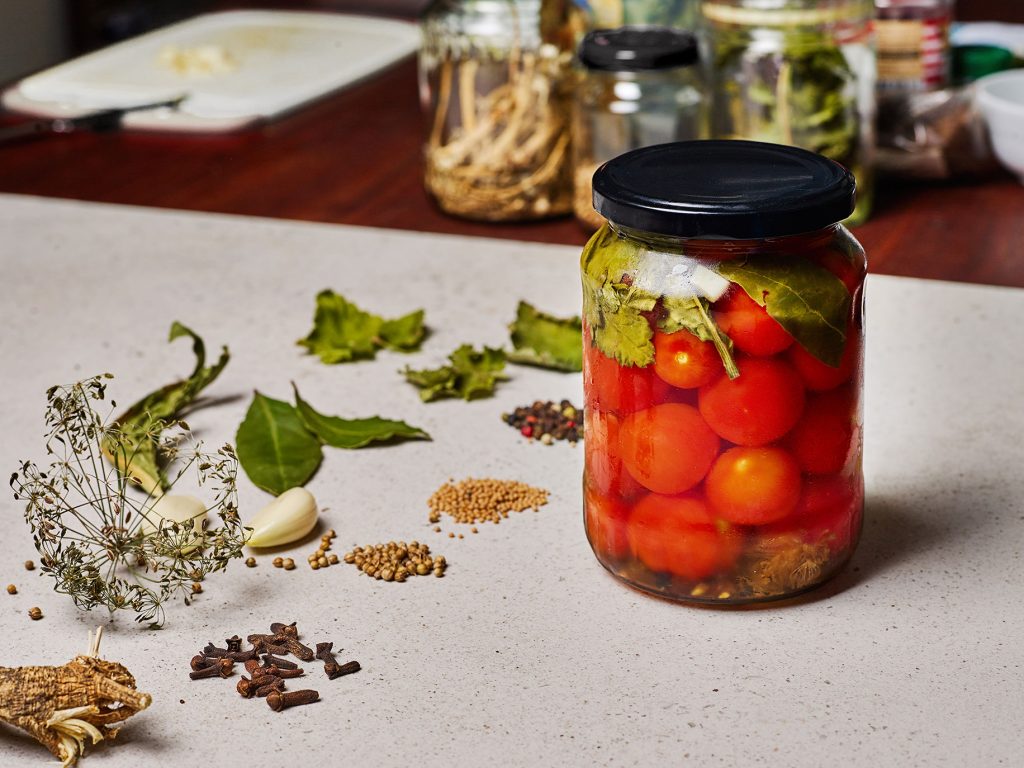It has to be said, if you’re buying store-bought pickles you’re simply missing out. Often commercially packaged pickled vegetables are made with minimum, simple ingredients – water, vinegar, salt, sugar – and given the lack of complexity, the contents inside the jar often taste bland; or worse, too vinegary or too sweet. Experimenting with your own pickling liquid and making your own range of pickled vegetables is highly rewarding, but what choices might one have in order to lift your flavour and aromatic game?
We’ve put together a range of ingredients that can be added (fresh or dried) to pickling jars and/or to your base pickling mixture while simmering. Experimenting is key, and using your sense of smell and imagination should be part of the tools used in order to define your own unique pickled vegetable result. Limiting your choices to following recipes to the letter is not advised, as it’s simply no fun! Instead, mix and match, blend and perfect. Mistakes can be made but that’s the pleasure of experimentation in learning.
Here’s a list of some of the pickling ingredients that we love to add:
Horseradish root – fresh or dried
If you’re a fan of horseradish then you’ll understand why it’s a great addition to your pickling jars. Simmer peeled root pieces with the pickling liquid, allowing them to soften a little. Then, add one or two pieces to each jar. Once pickled, the horseradish can be sliced to add some generous ‘kick’ to your meal.
Horseradish leaves – fresh or dried
A subtle herbaceous element combined with some heat can be the result of adding horseradish leaves to your pickle jar. As with any leaves, decorate the side of the jar with the leaves as you pack in the vegetables, then pour in the warm pickling liquid.
Dill Flower – fresh or dried
Dill flowers contain the seeds which are both nutty and aromatic. While dill flowers (and leaves) are best used fresh in pickles, the dried seeds can add an earthier-toned addition to the pickling flavour.
Garlic Cloves – freshly peeled
Adding freshly peeled garlic gloves to your pickled vegetables can add a powerful flavour and heat addition to the finished result. They’re great combined with pickled cucumbers, tomatoes and carrot; however they should be used sparingly unless you really love garlic. 2 cloves per large jar is all that’s required. The pickled cloves can also be sliced and eaten on rye bread.
Bay Leaves – fresh or dried
The essential oils within bay leaves can add a gentle herbaceous element combined with a sweeter floral aroma and taste. Slow simmer the leaves in the pickling liquid to release their oils, but use sparingly as they can easily overpower.
Currant Leaves – fresh or dried
Currant (or other berry leaves), added fresh or dried to the jar before pouring in the pickling liquid, is a magical ingredient to experiment with. Currant leaves add a unique grassy and aniseed element that’s both sweet and herbaceous. Russians pickle with skill and pick them with care and treat them as gold. Not to be underestimated, adding 2/3 leaves per jar is sure to add both beauty and aromatic brilliance to your pickled vegetables.
Cloves (spice)
Cloves are a powerful spice that can add depth of character to the pickling liquid while powerfully permeating the vegetables in it. Use a teaspoon of cloves per large jar with pickled tomatoes.
Coriander Seeds
Coriander seeds have a lemony citrus flavour when crushed. However, as they’re added to a simmering pickling liquid, warm, nutty, orange-flavoured aromatics are released. The addition of the seeds will add a wildly beautiful aroma and subtle taste to your pickled vegetables. Try them with pickled carrots, cucumbers, zucchini, cauliflower and cabbage.
Mustard Seeds
Again, here’s another simple addition that once simmered with the pickling liquid can add some warming spice and wonderful subtle sweet nutty aromas. An excellent addition to most pickles.
Peppercorns
A mixture of red, green and black peppercorn are simple additions that can add a beautiful floral and fiery element.
Which vegetables to try pickling:
Green vegetables: spinach, silver beet, chard and kale.
Root vegetables: potato, carrot, swede, turnip and beetroot.
Brassicas: broccoli, romanesco (broccoli), cauliflower and cabbage.
Other vegetables: Avocado, garlic, tomato, zucchini and cucumber.
How to Properly Sterilise Jars for Pickling, Preserves or Fermenting
For best results we recommend you follow the simple steps to properly sterilising your pickling jars and lids.
See our article: How to Properly Sterilise Jars for Pickling, Preserves or Fermenting.



Comments are closed.